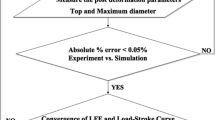Abstract
This manuscript presents a combined numerical and experimental methodology for determining the stress-strain curve of metallic materials from the measurements of force and displacement obtained in the axial compression of cylindrical test specimens with friction between the specimens and the platens. The methodology is based on minimizing the error between the average surface pressure obtained from the experimental measurements of the force and displacement and that obtained from the slab method of analysis of metal plasticity. Three different friction models based on Coulomb friction, the constant friction model or combined friction models are utilized. Experimental results obtained from cylindrical and Rastegaev test specimens with different lubricants combined with the experimental determination of friction by means of ring compression tests allows compensating the effect of friction in the determination of the material flow curve. Comparison with the flow curves determined without friction compensation shows the viability of the proposed methodology. The proposed methodology is a simple and effective alternative to other solutions available in the literature and the pseudo-code supplied in the Appendix is provided for those readers interested in utilizing the associated numerical algorithm for determining the stress-strain curves of metallic materials.









Similar content being viewed by others
References
Rastegaev MV (1940) Neue Methode der homogenen Stauchung. Zavodskaja Lab:354–355
Cook M, Larke EC (1945) Resistance of copper and copper alloys to homogeneous deformation in compression. J Inst Met 71:371–390
Alexander JM, Brewer RC (1963) Manufacturing properties of materials. Van Nostrand, London
Watts AB, Ford H (1955) On the basic yield stress curve for a metal. P I Mech Eng 169:1141–1156
Woodward RL (1977) A note on the determination of accurate flow properties from simple compression tests. Metall Trans A 8A:1833–1834
Avitzur B (1968) Metal forming: processes and analysis. McGraw Hill, New York
Osakada K, Kawasaki T, Mori K (1981) A method of determining flow stress under forming conditions. Ann CIRP 30:135–138
Han H (2002) The validity of the mathematical models evaluated by two-specimen method under the unknown coefficient of friction and flow stress. J Mater Process Technol 122:386–396
Mielnik E (1991) Metalworking science and engineering. McGraw Hill, New York
Xinbo L, Fubao Z, Zhiliang Z (2002) Determination of metal material flow stress by the method of C-FEM. J Mater Process Technol 120:144–150
Tan X, Zhang W, Bay N (1999) A new friction test using simple upsetting and flow analysis. Adv Technol Plast 1:365–370
Wilson WRD (1979) Friction and lubrication in bulk metal-forming processes. J Appl Metalwork 1:1–19
Hollomon JH (1945) Tensile deformation. T Am I Min Met Eng 162:268–290
Swift HW (1952) Plastic instability under plane strain. J Mech Phys Solids 1:1–18
Ludwik P (1909) Elemente der technologischen mechanik. Springer Verlag, Berlin
Voce E (1948) The relationship between stress and strain for homogeneous deformation. J Inst Met 74:537–562
Chapra S, Canale R (2009) Numerical methods for engineers, McGraw-Hill
Nielsen CV, Zhang W, Alves LM, Bay N, Martins PAF (2013) Modelling of thermo-electro-mechanical manufacturing processes with applications in metal forming and resistance welding. Springer, London
Acknowledgments
The authors would like to acknowledge the support provided by The Danish Council for Independent Research under the grant number DFF – 4005-00130. Paulo Martins would also like to acknowledge the support provided by Fundação para a Ciência e a Tecnologia of Portugal under LAETA – UID/EMS/50022/2013 and PTDC/EMS-TEC/0626/2014.
Author information
Authors and Affiliations
Corresponding author
Appendix 1
Appendix 1
A pseudo-code is listed in the appendix enabling the reader to perform friction correction in upsetting experiments. The used names for variables are explained during the code. The pseudo-code is written in MATLAB version 14.

Rights and permissions
About this article
Cite this article
Christiansen, P., Martins, P. & Bay, N. Friction Compensation in the Upsetting of Cylindrical Test Specimens. Exp Mech 56, 1271–1279 (2016). https://doi.org/10.1007/s11340-016-0164-z
Received:
Accepted:
Published:
Issue Date:
DOI: https://doi.org/10.1007/s11340-016-0164-z




